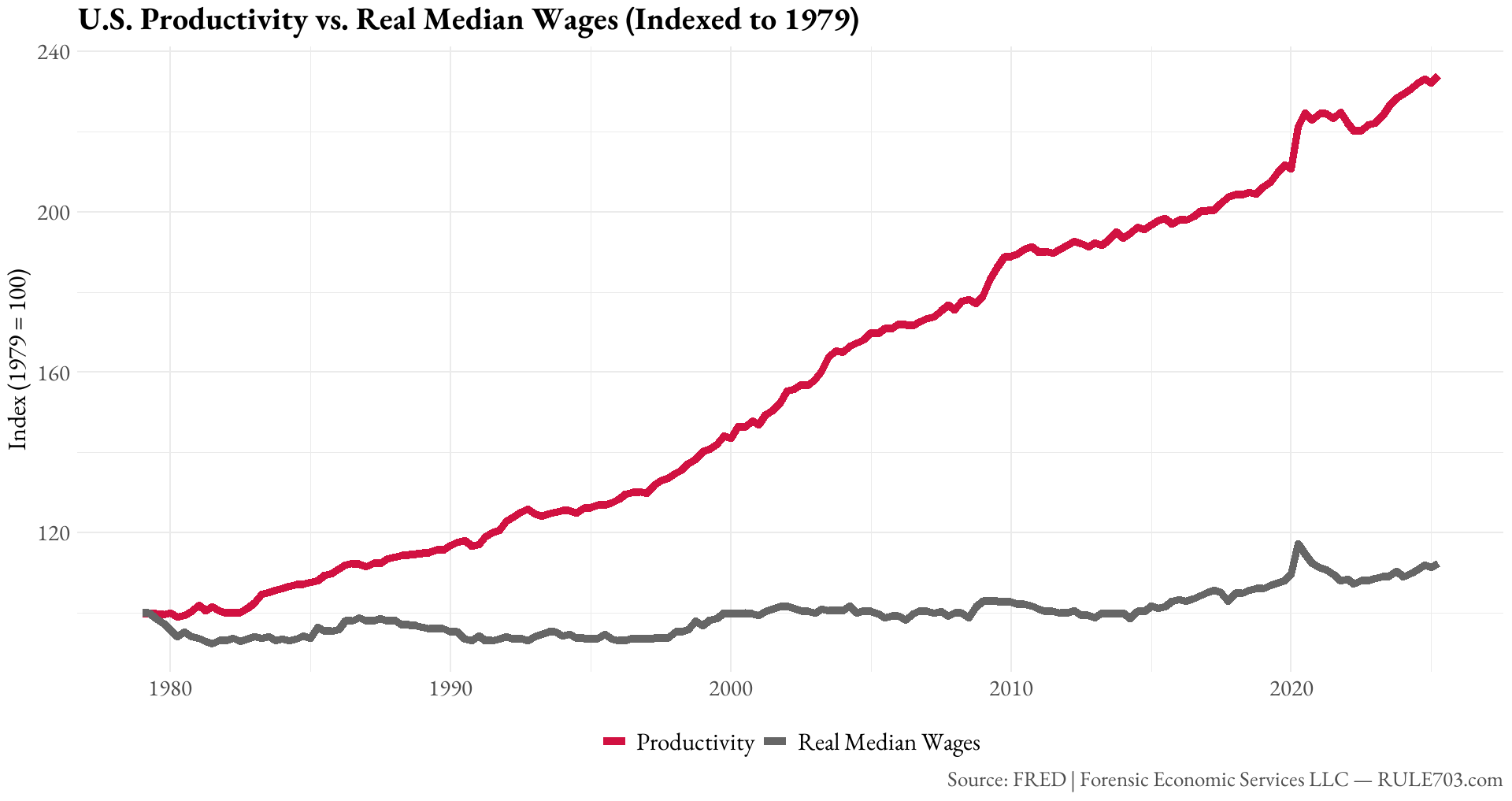
Data source: Federal Reserve Bank of St. Louis (FRED)
- Productivity: Nonfarm Business Sector: Output per Hour of All Persons (OPHNFB)
- Real Median Wages: Real Median Usual Weekly Earnings of Full-Time Workers (LES1252881600Q)
Visualization created in R using:
fredr, tidyverse, lubridate, scales, showtext, patchwork
Over the past four decades, U.S. productivity has more than doubled, while real median wages have barely moved. The gap between worker output and pay began long before AI — suggesting structural or policy factors play a larger role.
by forensiceconomics

19 Comments
I always wonder what this means.. do people expect their wages to go up because their productivity does?
Even when much of this productivity can be related to better and better tools to do the job? Tools that cost companies billions (globally) a year to provide to their employees?
just in case people don’t know … “real” median wages takes inflation into account. So this indicates that Median wages have increased faster than inflation, appearing to have accelerated pretty nicely since 2015.
I know many will respond with objections or with the fact that housing has gone up more quickly or whatever, and you’re welcome to do so … I’m just providing a bit of context to the chart.
Doesn’t this prove keeping wages low is the smart move because you can keep squeezing blood out of workers?
How is “Productivity” actually measured though
Guys, im sorry to say that the retirement age is going up and we’re reducing benefits. We just can’t afford it!
This analysis has been done a few times and has methodological issues. See https://www.piie.com/blogs/realtime-economic-issues-watch/growing-gap-between-real-wages-and-labor-productivity
That one graph describes the fall of the American Empire.
This graph gets passed along a lot and it’s a famous chart-crime.
1) What deflator did you use on productivity? Was it the same deflator you used for wages or are you comparing apples to oranges?
2) Benefits as a share of total compensation has increased substantially since 1970. The cost of healthcare is being used to deflate the wages, but the value of the healthcare benefit is not included
3) Are you using median worker productivity or average worker productivity? Why would you use average for one line but median for the other?
The answer to all of these questions is “I used the easiest thing”, but when you actually go make an apples to apples comparison (say by using nominal values or the same inflation adjustment, using median personal income, and average wage or median productivity) **more than 50% of this “gap” vanishes**!
Is the productivity also “real” or inflation adjusted? Or is this just a fancy graph basically showing us the difference between adjusting or not adjusting for inflation?
Is that Ron Reagan’s music??
There is a finite amount of wealth, and this is what happens when billionaires hold a significant portion of it.
You know what’s interesting? The gap between the two lines is basically the wealth of the shareholders.
It’s because of the inflated labor pool from illegal aliens and visas. Labor has no leverage because companies have an unlimited global pool to choose from.
They hate to see we work so much harder and more efficiently now. Greed is destroying everything
Am I reading this right that productivity rose in 2020 because most of the useless people were given time off work?
Why does anybody believe those two things should be comparable? Increased “worker productivity” doesn’t mean that workers are just working harder.
If you work on an assembly line and it’s your job to tighten nuts with a wrench, you might tighten 1000 nuts a day. The day your employer gives you a pneumatic driver, that might go to 2000. Now, you’re TWICE as productive as you were. But, that’s not because you’re working twice as hard. Heck, your work is probably easier with the better tool.
This graph looks like the 1920s graph between productivity and wages. The only reason this up coming recession won’t be as bad as the 30s depression is there are some social safety nets. Which unfortunately conservatives are trying to get rid of.
Capital investment is the missing factor in your productivity. Your labor alone isn’t what’s keeping productivity soaring.
In simple economics terms: Q = K * L
Can you do the same for france please ? 🙏